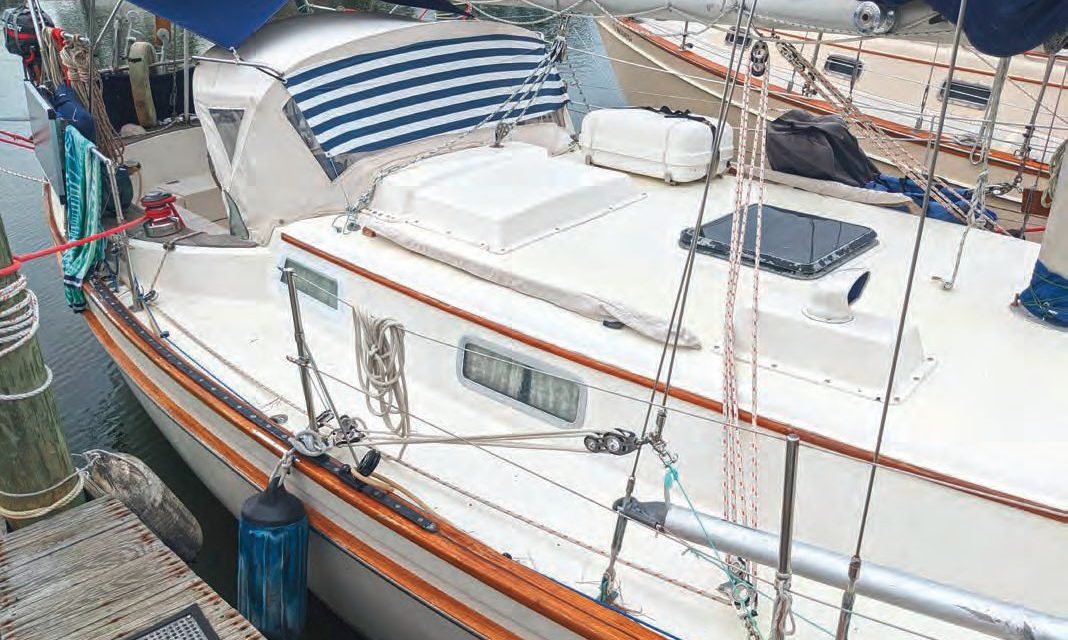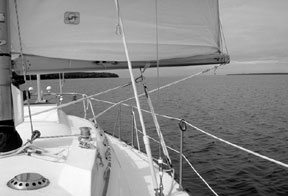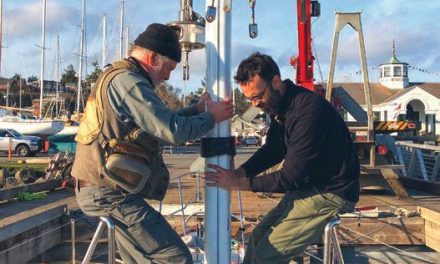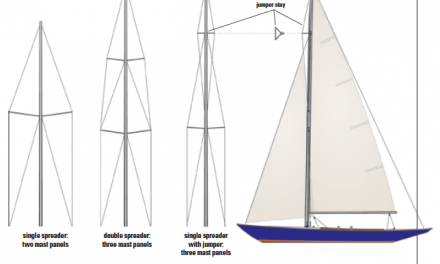Taking inspiration to create a more functional and gooseneck-friendly vang/preventer
Issue 154: Jan/Feb 2024
I started sailing as an adult and honed my skills racing on San Francisco Bay aboard other people’s boats. On my first day on the water, I managed the traveler for a fun day on my now-husband’s Ericson 34, Dreamcatcher. I loved learning when to release one side and haul in the other, all while new friends managed other parts of the line handling during a tack. I was hooked and joined other race crews so I could get out multiple times per week.
After a few seasons on the rail, I earned a spot trimming spinnaker and jib. In sail trim, there is an easeful intensity and specificity that I haven’t found present in other hobbies. I enjoy sewing and knitting and being outside, so tuning fabric to the wind was pretty heavenly.
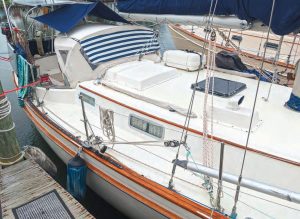
On Azimuth, note the red and white line that leads from the cockpit combings, along the bulwarks, to a set of block and tackles, and up to the boom.
When my husband, Scott, and I purchased our Pearson 365 sloop, Azimuth, it had just about everything we had been looking for in a liveaboard cruiser — stout design and construction, modest sailplan, large cockpit, standing shower, and a U-shaped galley. The one catch I recall was that the only deck-mounted control for the mainsail was the mainsheet. We could adjust the sail a little bit more with the outhaul and halyard tension, but that was it.
In 2018, we began planning a trip down to Monterey with Scott’s father and sister aboard Azimuth. We had sailed out the Golden Gate Bridge many times, but never for this many miles nor while hosting guests. We combed the boat for ways to be more prepared for the journey and in doing so found a crack developing in the gooseneck. Our initial idea was to bring it to a rigging shop and ask about getting it welded. On a sunny day in September, we drove up to KKMI boatyard and explained our quest. The man working at the shop that day explained that he could certainly weld the gooseneck to reinforce it, but also added that we should consider the cause behind this symptom. Without additional controls on the mainsail, our boom tended to twist when going downwind and the gooseneck took most of the pressure. We filed this information away for another day and continued prepping for our short cruise.
A few years later, we had set our sights on sailing from California to the Chesapeake Bay via the Panama Canal. It was time to find a solution to the twist in the main, as well as rig a preventer to avoid accidental jibes. Scott recalled an old issue of Good Old Boat in which Jerry Powlas described a combination vang/preventer on his and Karen’s C&C 30, Mystic.
Here’s Jerry’s description of the system:
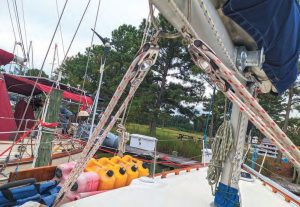
Each block and tackle connects via a
boom bale through-bolted to the boom.
“Vang/preventer? We knew of no existing term for this rigging, and we had to call it something. On Mystic, the vang/preventer is a pair of 4:1 tackles leading from mid-boom to the port and starboard toerails just abaft the stays. A single control line runs from both tackles aft through fairleads and cam cleats port and starboard of the helm. Because there is only a single line, as the boom swings off, line taken by one tackle is given up by the other, so very little excess line clutters the cockpit. A flick of the wrist controls the boom.
On Mystic, the vang/preventer is actually a better vang, a better preventer, and a better traveler than anything else we could have devised. Mystic had a traveler when we bought her, but it was a simple affair with no control lines. The idea was to lift the detent pin and move the car stop to the new location. The traveler was about 2 feet long and resided on a beam between the cockpit seats just in front of the wheel. It could not be moved under load and was only useful when beating. It was too short to help on a reach.”
With Jerry’s plan in mind, we sourced two 4:1 block and tackles from Garhauer, a boom bail from Defender, and enough line to run the system in a continuous loop. We then positioned it aft enough to provide proper leverage, but not so far as to hit the center hatch. The ends of the line were tied onto the block and tackle, and the slack lay in the cockpit. We added cam cleats to the cockpit combings and everything could be managed without going forward, often without even getting up from our seat. Other sailors often asked about this system and we inspired at least one crew to install something similar on their vessel.
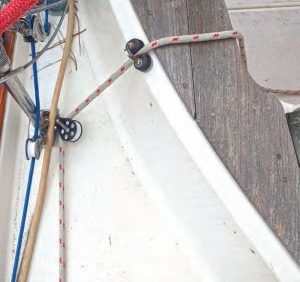
A cam cleat facilitates easy sheeting, allowing one person to tighten or loosen each side.
But how did it hold up?
We used this vang/preventer system for over 9,000 miles in the course of two years. The only maintenance required was soaking the lines in laundry detergent to soften them after our boat sat docked for a season while the trade winds blew offshore in Cartagena, Colombia, in 2022. The gooseneck had no further problems now that the main remained flatter downwind and I’m sure this system avoided a few accidental jibes on the long, rolly passages downwind on the Pacific coastline of Mexico and Central America. These lines did provide another obstacle to cross when we moved forward, requiring us to reclip the double-ended tethers onto the jackline, but overall we felt this tradeoff to be worth it in avoiding a preventer that needed to be connected near the bow.
Ashley Gremel is a writer, maker, and problem solver. She recently completed a voyage from San Francisco to the Chesapeake Bay with her husband, Scott Racette, and their salty cat, Cypress. The trio is settling down in Richmond, Virginia, and dreaming of the next cruise. Ashley writes weekly at cloudsformoverland.substack.com.
Thank you to Sailrite Enterprises, Inc., for providing free access to back issues of Good Old Boat through intellectual property rights. Sailrite.com

